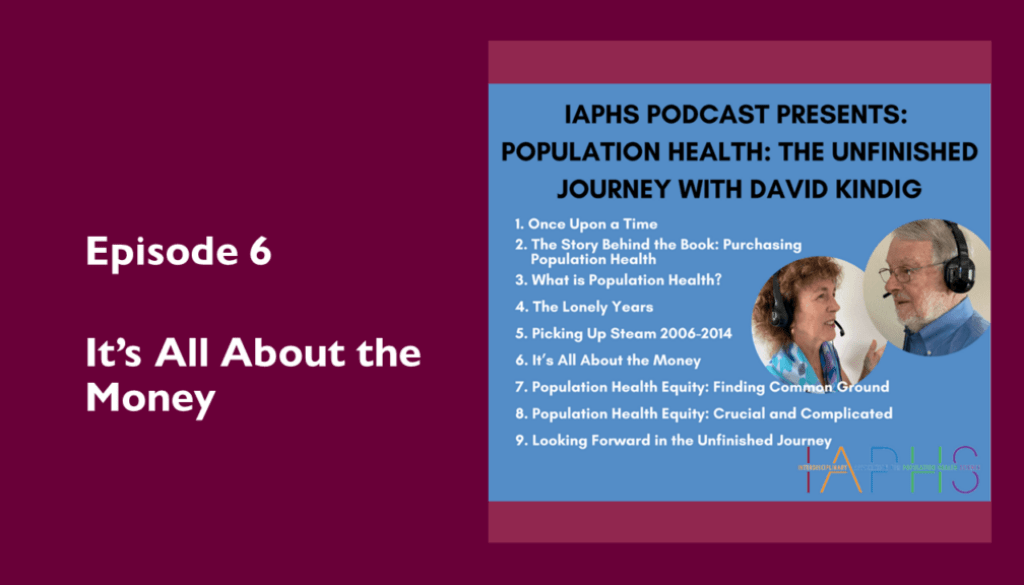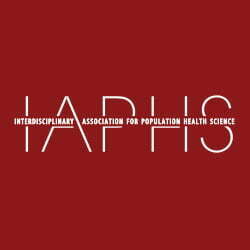Population Health – The Unfinished Journey with David Kindig: Episode 6, “It’s All About the Money”
IAPHS StaffIn nine podcasts, David Kindig MD, PhD, a population health thought leader, is interviewed by Sanne Magnan MD, PhD about Kindig’s 50-year population health scholarly and policy journey, including many stories, anecdotes, and takeaways. In our corresponding blog posts, we highlight some of the key moments and take-aways as a reminder for you to tune into previous and future podcasts.
You can listen to the Episode 1: “Once Upon a Time,” here; Episode 2, “The Story Behind the Book” here; Episode 3, “What is Population Health?” here; Episode 4, “The Lonely Years” here; and Episode 5, “Picking Up Steam” here.
Overview
In this episode, Dr. Kindig explains why finding stable funding is key–but challenging, too. Voluntary funding will never be enough—he reminds listeners about the 1960s anti-war poster that said, “What if they had to hold bake sales to build a bomber?”
Where should the money come from, then? Reallocating money from ineffective or wasteful healthcare spending is appealing, but the resistance to this method is powerful, and Accountable Care Organizations aren’t delivering yet, Dr. Kindig tells Sanne. The community benefit funds from hospitals are another source—and already embedded in the IRS tax code—but there’s no teeth in the regulation, and so far, there’s been no policy movement.
Community multisectoral partnerships, referred to as “health outcome trusts” in Dr. Kindig’s 1997 book, could flourish today if given a steady stream of “backbone” resources. Dr. Kindig suggests the next step for health investment benchmarks should be determining how much per capita on each determinant is needed to move the outcome, but this requires more research.
Finally, Dr. Kindig explains that it’s not all about money. Other incentives—regulatory, legal, reputational, educational—exist, but aren’t powerful enough to overcome the huge challenges of improving health and equity.
Episode Highlights
- There’s no single source of resources for population health investment. We need all private and public sectors to do their share.
- Excessive health care expenditures today are the perfect storm of American culture: wanting more of everything now, greed in medicine, fascination with technology, and so on. As Starr said in The Social Transformation of Medicine, professional power gets medical care expansion without controls. Going forward, keep a wary eye on geonomics and personalized medicine.
- There is promise in community multisectoral partnerships that include business as well as government, nonprofits like United Way, healthcare, and public health, but these partnerships need core resources to function effectively.
- We need much more research on relative cost-effectiveness so that cross-sectoral investment benchmarks can be set.
Please join us next week for Episode #7, “Picking Up Steam,” as we continue exploring Fifty Years of Pursuing Population Health with Dave Kindig: The Unfinished Journey. We encourage you to review the resources below before listening to Episode 7.
Resources
Kindig D and Isham G. 2014. Population Health Improvement: A Community Health Business Model That Engages Partners in All Sectors. Frontiers in Health Services Management 30 (4): 3-20. (This paper won the 2014 ACHE Dean Conley Article of the Year Award.).
Rosenbaum S, Kindig D, Byrnes M, et al. 2015. In 2011, the Estimated Size of the Nonprofit Hospital Tax Exemption Surpassed $24 Billion. Health Affairs 34:7;1225-1233.
Bakken E and Kindig D. 2012. Is Hospital Community Benefit Charity Care? Wisconsin Medical Journal 111 (5): 215-219.
Magnan SJ, Kindig DA .2018. Population Health Revisited. Population Health Management Apr 22(2):91-92.doi: 10.1089/pop.2018.0043.
Kindig D. To Launch And Sustain Local Health Outcome Trusts, Focus On ‘Backbone’ Resources. Health Affairs Blog February 10, 2016.
Kindig D. 2015. From Health Determinant Benchmarks to Health Investment Benchmarks. Preventing Chronic Disease 12:150010.
Kindig D and Milstein R A 2018. Balanced Investment Portfolio for Equitable Health and Well-Being Is an Imperative, and Within Reach. Health Affairs 37:4. https://doi.org/10.1377/hlthaff.2017.1463.





All comments will be reviewed and posted if substantive and of general interest to IAPHS readers.